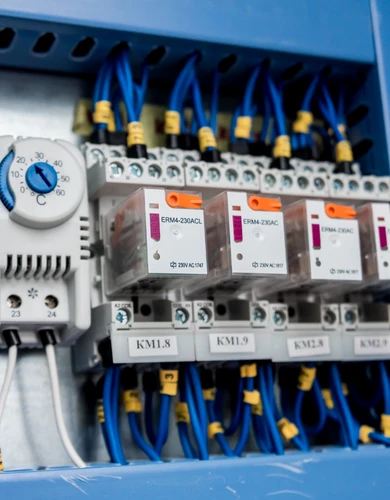TNUoS charges for businesses
TNUoS charges constitute approximately 10% of domestic and business electricity prices and cover the cost of operating and developing Britain’s high-voltage national grid.
There are two types of TNUoS charges:
- 75% of overall TNUoS charges are demand-based tariffs paid by homes and businesses with an electricity connection.
- The remaining 25% are paid by electricity generators connected to the national grid.
This guide explains how both elements of TNUoS charges work and how they impact domestic and business electricity bills.
We also discuss the strategies that allow businesses to reduce their TNUoS charges.
What are TNUoS charges?
The acronym TNUoS stands for Transmission Network Use of System. TNUoS charges cover the costs associated with operating and developing Britain’s high-voltage transmission network, often called the National Grid.
This differs from DUoS charges, which cover distribution costs through the regional distribution networks.
The national grid is independently owned and operated by three organisations that earn TNUoS charges:
- Scottish & Southern Electricity Networks – operates the transmission infrastructure in the Northern Scotland (part of the same group as SSE Business Energy)
- Scottish Power Energy Networks – operates the transmission infrastructure in the Southern Scotland (part of the same group as Scottish Power Business Energy)
- National Grid – operates the transmission infrastructure in England and Wales.
An organisation called NESO serves as the principal operator of the entire system and collects TNUoS charges on behalf of the three individual owners.
Total TNUoS charges are estimated to reach £5.1 billion in 2025/26, which will support safe, reliable, and efficient electricity transmission across Britain.
Demand TNUoS tariffs
Demand TNUoS tariffs are levied on all homes and businesses connected to the electricity grid in Britain.
There are three types of demand-based TNUoS charges:
- Fixed daily charges – these constitute the majority of demand-based TNUoS charges.
- Location-based charges – an additional charge for certain locations.
- Triad period demand – an additional demand-based charge for industrial users during times of peak demand on the network.
Fixed daily demand charges
The majority of TNUoS demand-based charges paid by users of electricity are a fixed daily charge that changes annually and depends your type of electricity connection.
The table below shows the TNUoS charges in 2025/26 for each type of domestic and business electricity connection.
| Type of business electricity connection | Maximum Import Capacity (KVa) | 25/26 final charges (£/day) |
|---|---|---|
| Domestic | N/A | £0.14 |
| Non-half hourly business low consumption | N/A | £0.15 |
| Non-half hourly business low/medium consumption | N/A | £0.36 |
| Non-half hourly business medium consumption | N/A | £0.76 |
| Non-half hourly business high consumption | N/A | £2.07 |
| Half-hourly LV1 | 0-80 | £3.91 |
| Half-hourly LV2 | 80-150 | £6.53 |
| Half-hourly LV3 | 150-231 | £10.25 |
| Half-hourly LV4 | 231+ | £22.74 |
| Half-hourly HV1 | 0-422 | £21.83 |
| Half-hourly HV2 | 422-1000 | £62.80 |
| Half-hourly HV3 | 1000-1800 | £121.80 |
| Half-hourly HV4 | 1800+ | £317.60 |
Source: NESO TNUoS scheme of charges 2025/26
A quick explanation of the types of electricity connections in the table above, with links to our detailed guides:
- Non half-hourly business customers – (MPAN Profile Classes: 01-04), generally small business energy customers.
- Half-hourly business customers – (MPAN Profile Classes: 00, 05-08) – commercial properties with high electricity demand fitted with a half-hourly electricity meter.
- Maximum Import Capacity – the maximum demand your business can draw from a connection as agreed with your distribution network operator.
Location-based demand charges
An additional TNUoS charge is levied on all domestic and business electricity connections in certain locations, particularly in the south of England and Wales.
There is no location charge for the north of England and Scotland, where connections are closest to the largest electricity generators and, therefore, use of the national grid is minimal.
The highest location charges are in the southwestern region due to the long distances electricity must travel to reach Devon and Cornwall.
Location-based TNUoS demand charges are applied as follows:
- Half-hourly customers – charged based on the capacity of a business electricity connection, measured in kW.
- Domestic and small business users – Paid for each kWh of electricity consumed.
Triad period demand
High-demand users pay an additional TNUoS charge based on their maximum demand during periods of peak demand on the national grid, known as “Triad periods,” which occur during the winter months.
The Triad period system incentivises large industrial electricity users to reduce consumption when demand is highest, helping to balance supply and demand across the entire system.
Generation TNUoS tariffs
Generation tariffs are paid by sites that generate electricity and export it directly to the national grid.
Generation TNUoS charges are based on the Maximum Export Capacity (in kW) of each facility.
The largest generators, such as the Drax power plant and the planned Sizewell C nuclear power station, pay the highest charges.
The charge per kW of capacity depends on the following two factors:
Location of generation
TNUoS charges depend on the location of electricity generation. Generators close to higher demand areas in the south of England pay the least, whereas generators in Scotland pay the most, as electricity has to travel the furthest distance to reach users.
Type of electricity generation
TNUoS generation charges depend on a “load factor,” a measure of how each type of generator uses the national grid from day to day.
There are three types of load factors applied.
Conventional low-carbon generators
Conventional low-carbon generators produce steady outputs of electricity throughout the year. The most common example of the traditional low-carbon generation is UK nuclear power plants.
Conventional low-carbon generators pay the highest TNUoS charges as they consistently use the transmission network, unlike the other generation types.
Intermittent renewable generation
Intermittent renewable generators produce electricity only in certain weather conditions, with UK wind farms being the most common example.
Intermittent renewables pay medium-level TNUoS charges as they frequently export power onto the grid but with variable timing, resulting in moderate transmission usage.
Conventional carbon generators
Fossil fuel-based electricity generators, most commonly UK gas power stations, pay the lowest TNUoS charges.
Conventional carbon generators are responsive, exporting power to the transmission network only when there is sufficient demand for the electricity they generate.
The lower TNUoS charges reflect the valuable role these generators play in balancing the grid.
The role of Ofgem in regulating TNUoS charges
Ofgem, the UK’s energy regulator, directly regulates TNUoS charges, approving the final charges each year to ensure they fairly reflect the use of the national grid.
Ofgem’s responsibilities include:
- Setting revenue limits: Ofgem determines the total allowed revenue that National Grid and other transmission operators can recover through TNUoS charges, ensuring costs are justified and reasonable.
- Approving charging methodologies: Ofgem reviews and approves the methodologies used to calculate TNUoS charges, including how costs are allocated between different regions, user types, and generation and demand customers.
- Encouraging efficiency: Through initiatives like the Targeted Charging Review (TCR), Ofgem assesses the fairness and predictability of TNUoS charges, aiming to balance costs between consumers and generators and promote efficient use of the transmission network.
Find out more in our guide to Ofgem’s role in business energy.
How TNUoS charges impact business electricity rates
Although TNUoS charges are applied separately for generators and users, both elements are ultimately paid by electricity users.
This section explains how TNUoS charges impact business electricity bills both through direct and indirect costs.
Direct impact of TNUoS on business electricity bills
Business energy suppliers pay demand-based TNUoS charges on behalf of their customers.
These demand-based TNUoS charges are typically included within the daily standing charge quoted in most business energy contracts.
The exception is pass-through business electricity tariffs, where your supplier will simply pass on any TNUoS and DUoS costs separately from the other components on your business electricity bills.
Indirect impact of TNUoS on business electricity bills
The largest component of business electricity bills is the commodity cost paid to electricity generators.
Electricity generators in Britain pay generation TNUoS tariffs for their connection to the national grid.
Generators then factor these TNUoS charges into the commodity cost per kWh that they charge to business electricity suppliers.
How can businesses reduce TNUoS charges?
TNUoS charges primarily depend on your business’s location and the capacity of its electricity connection, making them challenging to avoid.
However, our energy experts can suggest three effective strategies to help reduce these charges.
Triad avoidance
Large industrial consumers pay triad charges based on their maximum demand during specific peak periods in the winter months.
Triad avoidance involves monitoring grid demand forecasts to predict triad periods, then adjusting operations or using energy storage to significantly reduce demand during those times.
Lowering Maximum Import Capacity
The banding of demand-based TNUoS charges for businesses with half-hourly meters is based on the agreed Maximum Import Capacity.
These businesses can lower their TNUoS charges by agreeing to reduce their import capacity with their local distribution network operator.
For a detailed explanation, refer to our guide on maximum demand.
Negotiations with suppliers
TNUoS charges are paid by business electricity suppliers, who typically apply a markup before passing them through in the daily business electricity standing charges of the tariffs they offer.
Businesses can often secure a better deal by comparing business energy suppliers and finding a tariff with the lowest daily standing charges.
Use our business electricity comparison service today to find the lowest TNUoS charges currently available on the market.

